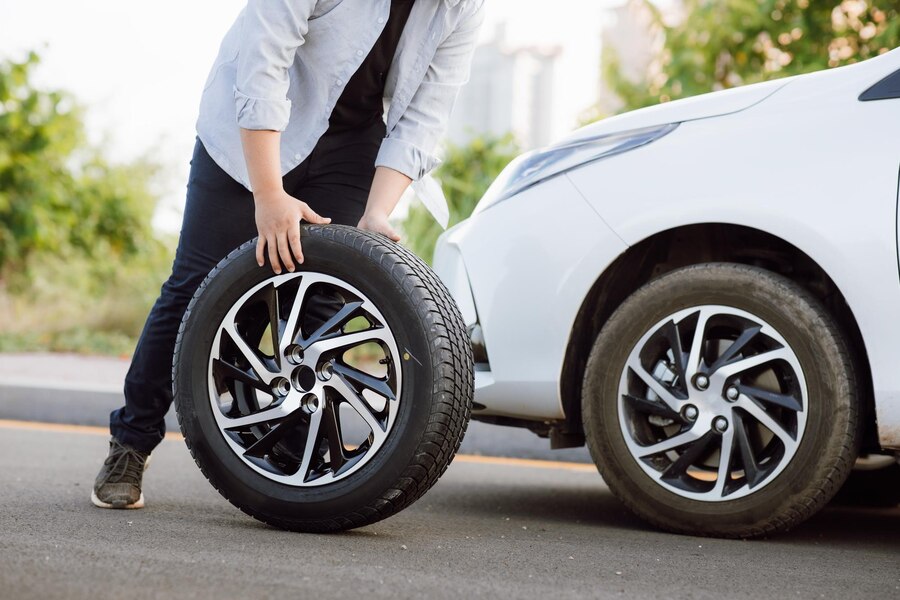Driving at night can be a serene and peaceful experience, but it can quickly turn into a nightmare when you encounter an unexpected flat tire. Dealing with a flat tire at night presents unique challenges, from ensuring your safety to performing the necessary repairs.
In this guide, we will walk you through the steps to handle this situation effectively and get back on your journey.
Read: “Why Flatbed Towing Service”
The Importance of Preparation
1. Prioritize Visibility
Ensuring you can see and be seen is crucial when dealing with a flat tire at night. Carry a flashlight, reflective vest, and reflective triangles in your vehicle at all times. These tools will help you stay visible to other drivers while you work on your car.
2. Familiarize Yourself with Your Vehicle
Before you hit the road at night, it’s essential to understand your vehicle’s make and model. Familiarize yourself with the location of the spare tire, jack, and lug wrench. Knowing where these items are will save you precious time and frustration when you need them.
Staying Safe on the Roadside
3. Find a Safe Location while flat tire at night
When you realize you have a flat tire, don’t panic. Gradually slow down, turn on your hazard lights, and carefully maneuver your vehicle to a safe spot off the road. Look for well-lit areas like a parking lot or a well-lit side street.
4. Alert Others
Once you are safely off the road, use your reflective triangles to create a visible barrier around your vehicle. This will alert other drivers to your presence and minimize the risk of an accident.
Get the best Flat Tire Change Service with Flag Towing!
Changing the Flat Tire
5. Turn Off the Engine
Before attempting to change the flat tire at night, ensure your vehicle is turned off. This will prevent any accidents caused by the vehicle suddenly moving.
6. Use Your Flashlight
Illuminate the area around the flat tire with your flashlight. This will make the process easier and safer.
7. Loosen the Lug Nuts
Using your lug wrench, carefully loosen the lug nuts on the flat tire, but do not remove them completely at this stage.
8. Jack Up the Vehicle
Position the jack under the vehicle in a designated lift point, typically indicated in your vehicle’s manual. Slowly raise the car until the flat tire is off the ground.
9. Remove the Flat Tire
Once the vehicle is lifted, fully remove the lug nuts and take off the flat tire. Be cautious, as it may be heavy.
10. Install the Spare Tire
Place the spare tire onto the wheel hub and hand-tighten the lug nuts as much as possible.
11. Lower the Vehicle
Slowly lower the vehicle back to the ground using the jack.
12. Tighten the Lug Nuts
With the vehicle on the ground, use the lug wrench to tighten the lug nuts securely.
Getting Back on the Road
13. Double-Check Everything
Before you drive away, double-check that all lug nuts are tightened properly and the spare tire is secure.
14. Store Your Equipment
Gather your tools, reflective triangles, and flashlight, and stow them back in your vehicle.
15. Resume Your Journey
With your spare tire in place and everything packed away, you can safely resume your trip. Remember to have the flat tire repaired or replaced as soon as possible.
Conclusion
Dealing with a flat tire at night can be stressful, but with the right preparation and knowledge, you can handle the situation safely and efficiently. Prioritize visibility, stay safe on the roadside, and follow the step-by-step process of changing the flat tire. By doing so, you’ll be back on your journey in no time, confident and secure.
Contact us now!
FAQs
Q1. What should I do if I don’t have reflective triangles in my car?
If you don’t have reflective triangles, use your hazard lights and flashlight to make your vehicle as visible as possible.
Q2. Can I change a flat tire at night alone, or should I wait for assistance?
You can change a flat tire alone if you have the necessary tools and feel comfortable doing so. However, if you’re unsure or feel unsafe, it’s best to wait for professional assistance.
Q3. How long can I drive on a spare tire?
Spare tires are meant for temporary use. It’s recommended to replace or repair the flat tire and return to normal tires as soon as possible.
Q4. What if I can’t find a well-lit area to change my tire at night?
If a well-lit area is unavailable, prioritize your safety by pulling as far off the road as possible, using your hazard lights, and calling for roadside assistance.
Q5. Should I carry a spare tire or a tire repair kit?
It’s best to have both. A spare tire is a reliable solution, while a tire repair kit can be a temporary fix for minor punctures until you can reach a repair shop.


